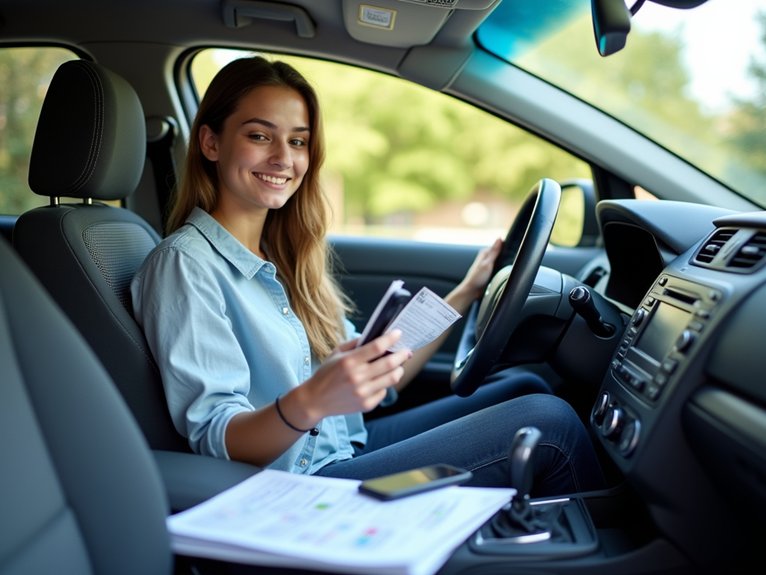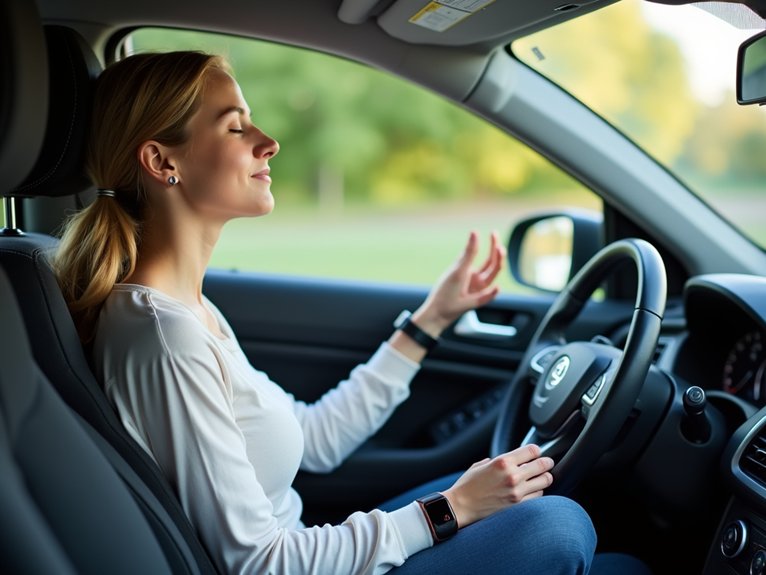Preparing for driving lessons requires both practical and mental readiness. New drivers should familiarize themselves with vehicle controls, traffic rules, and road signs beforehand. Wearing comfortable clothing, arriving early, and bringing necessary documentation guarantees a smooth first lesson. Deep breathing techniques help manage anxiety, while establishing good habits like proper hand positioning and regular mirror checks from day one accelerates progress. Open communication with instructors maximizes learning. The following strategies provide thorough preparation for success behind the wheel.
Essential Pre-Lesson Knowledge for New Drivers

Before stepping into a car for their first driving lesson, new drivers should familiarize themselves with basic vehicle controls and driving concepts.
Understanding the dashboard indicators, location of the gear shift, turn signals, and emergency brake provides confidence during initial lessons. New drivers benefit from studying road signs, traffic rules, and right-of-way principles beforehand.
Learning the meaning of common driving terminology—such as blind spot, parallel parking, and three-point turn—helps students absorb instructions more effectively.
Additionally, reviewing the driver’s handbook from the local licensing authority establishes a foundation of knowledge that accelerates the learning process and promotes safer driving practices.
Practical Steps to Take Before Your First Driving Lesson
While theoretical knowledge forms the foundation for learning to drive, practical preparation directly impacts the success of a first driving lesson.
New drivers should guarantee they have a valid provisional license and appropriate eyewear if needed. Wearing comfortable clothing and flat, secure footwear enhances control of pedals. Adequate rest before the lesson improves concentration and reaction times.
Arriving 10-15 minutes early allows time to discuss lesson plans with the instructor. Bringing required documentation, including identification and payment, prevents administrative delays. Finally, learners should eat a light meal beforehand to maintain energy without discomfort during the driving session.
Mental Preparation and Anxiety Management Techniques

Mental Preparation and Anxiety Management Techniques
Driving anxiety affects approximately 75% of new learner drivers, making mental preparation as essential as practical skills development. Effective techniques include visualization exercises where learners mentally rehearse driving scenarios before encountering them physically.
Deep breathing and progressive muscle relaxation can calm the nervous system when feeling overwhelmed. Learners benefit from establishing a pre-driving routine that includes positive affirmations and realistic goal-setting for each lesson.
Acknowledging that mistakes are part of the learning process helps reduce perfectionist tendencies that amplify anxiety. Students should communicate concerns openly with instructors, who can adapt teaching methods to accommodate individual comfort levels.
Building Good Habits From Day One
Building Good Habits From Day One
The foundation of skilled driving begins with establishing proper habits during initial lessons. New drivers should focus on consistent mirror checks, proper hand positioning at 9 and 3 o’clock, and maintaining appropriate following distances. Instructors recommend developing a pre-drive routine including seat and mirror adjustments before starting the engine.
Learners benefit from actively verbalizing their observations while driving, which reinforces awareness patterns. Additionally, correctly positioning hands during turns and avoiding distractions establishes vital safety behaviors.
Documentation of each lesson’s challenges and achievements helps track progress and identifies areas needing improvement.
These habits, when formed early, become automatic responses that serve drivers throughout their driving careers.
Making the Most of Your Instructor’s Guidance

Making the Most of Your Instructor’s Guidance
Beyond establishing foundational habits, students must actively engage with their instructor’s expertise to maximize learning outcomes. Successful learners ask clarifying questions, take notes between lessons, and request feedback on specific skills they find challenging.
Instructors observe patterns in a student’s driving that may not be apparent to the learner. By remaining receptive to constructive criticism and implementing suggested techniques, students develop proper driving mechanics more efficiently.
Recording key points after each lesson helps reinforce concepts and identifies areas needing additional practice. Students should communicate their learning preferences clearly, enabling instructors to tailor their teaching approach appropriately and focus on the most relevant skills for the individual’s development.



